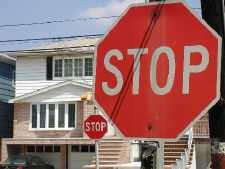For Lenny Zak, resident of Seventh Street, an unusual silence has come over the old neighborhood. While he can still hear the buzz of traffic from nearby Bayonne Bridge as well as the streets around his house, he no longer hears the frequent squeal of breaks and crash of metal.
Zak, who has lived in the neighborhood for about 26 years, said he could tell there was another accident outside his house by the sound of the boom. “We had a lot of accidents here,” Zak said. “But the most serious was when that kid got killed here.”
Although accidents were routine at the intersection of Avenue C and Seventh Street, the neighborhood was spurred to action when a motorcycle was struck coming out of Avenue C and its driver killed.
“People used to get creamed,” Zak said. “People wouldn’t stop at the stop signs. People make turns into the wrong lanes.”
Residents said Seventh Street has previously felt like a race way as cars rush off the exit from the Bayonne Bridge and charge passed their homes. This is an odd intersection because many of the streets in the Bergen Point section do not line up completely with the grid work of upper Bayonne.
Coming north on Avenue C from Dennis Collins Park, drivers come to a T in the road. In order to continue on Avenue C, they had to turn right, drive a block, and make a left to where Avenue C continues north.
Prior to the installation of new larger stop signs and other safety measures, cars coming up Avenue C slowed but often did not stop, risking collisions from cars rushing down seventh Street from the bridge.
“The motorcycle came through the intersection,” Zak said. “The women driving the other car swerved to avoid him but hit the motorcycle sending it skidding along on its side.” The motorcycle driver slid under a parked pickup sustaining injuries so severe EMTs could not give him CPR.
“We have three nurses living near here and they couldn’t help him either,” Zak said. Residents were so upset by this accident that they held a meeting at Veterans Hall last April. More than 70 people showed up. Mayor Joseph Doria and Councilman Ted Connolly promised to take definitive action to slow traffic and stop any future loss of life.
Frank Carine, director of the City’s Department of Public Work, said Seventh Street and Avenue C was by far the most dangerous intersection in Bayonne.
“We got more reports about accidents here than any place else,” he said. “While most of them were fender benders, once that kid got killed, the neighbors got together with the mayor and Councilman Connolly to put a stop to it.”
Safety changes may stop accidents
Since the April meeting, the city has made a series of basic changes to the intersection. Some changes were minor such as re-striping the street in order to highlight the warnings.
“I told them that the stop sign on Seventh Street was too small,” Zak said.
So the city put in a larger sign.
Other changes were more substantial, such as moving flashing lights further out into the street. Until that point, the warning lights stood at the curb, but Carine said the city installed an arm that hung the light over the center of the street.
So far the city has moved one of the lights near the continuation of Avenue C and will soon install the second at the intersection where the accident occurred.
Joe Ryan, the public resources representative for the mayor’s office, said an oddity in state law restricts the city from putting a traffic light at the intersection.
“We’ve approached the state in the past,” he said. “But apparently the state does not recognize a T as an intersection, so they won’t approve the installation of a light.”
Many residents were unaware of the fact that all traffic lights must be approved by the state Department of Transportation. This is an arduous process that involves a history of reported accidents, traffic studies and such. The cost can be as much as $100,000 per light.
“Many people believe we have a room somewhere from which we can pull out a traffic light when we need one,” Ryan said. “That’s not true. We have to get approval from the state.”
Carine said, knowing that the state would not approve of the installation of a traffic light, he and others including Matt Guerra, coordinator of the police and fire department’s signal division, began to shape a plan of action that would cut down the risk people faced when traveling through this intersection.
To help slow down traffic along Seventh Street, Carine’s crew installed speed bumps – a series of rubberize bumps that can be taken up in winter to allow for plowing – which forces cars to slow down when approaching the intersections. To go with these, the city also installed signs warning drivers of the bumps.
“It’s make a big difference,” Zak said. “It has slowed people down.”
Of course, people are still getting use to the changes, and many drivers seem a bit stunned when confronted with the series of speed bumps. Other drivers still do not stop at the stop sign.
“They’re going to have to get used to the changes,” Carine said.
Zak added, “At least with the bumps people aren’t zipping through here.”
